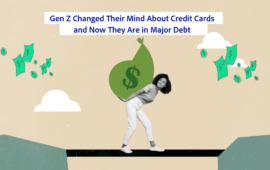Strategies and Tips to Pay Off $75,000 Worth of Debt
About Harrison
Harrison Pierce is a writer and a digital nomad, specializing in personal finance with a focus on credit cards. He is a graduate of the University of North Carolina at Chapel Hill with a major in sociology and is currently traveling the world.
Read full bio
At a Glance
American credit card debt is at an all-time high. The total credit card balance for the U.S. is $1,031 trillion for the second quarter of 2023, according to the latest consumer debt data from the Federal Reserve Bank of New York. Due to inflation, more people are relying on their credit cards to pay for essentials like food and rent, and they’re having difficulty paying on these balances and staying ahead. Another concerning metric is the uptick in delinquencies, which has now surpassed pre-pandemic levels, according to a study from TransUnion. Gen Z has been hit particularly hard, as many are entering the job market for the first time during this period of inflation.
If you’re feeling the crushing weight of your credit card each month, here’s how you can pay off your balance.
Ways to pay off $75,000 of credit card debt
There are a myriad of different strategies a person can use to begin to take a stab at paying off their debt and no option is truly a bad one. However, the following five strategies are among the best to consider:
1. Credit card debt consolidation
The first strategy to consider when trying to reduce the $75,000 credit card debt or potentially more that you have in debt is to consolidate your credit card debt. This means to move as much debt as possible to a single card, or a couple cards, to reduce the number of payments and interest rates you have to juggle on a monthly basis. This can help you keep your debt more organized while also saving you money. Debt consolidation loans and balance transfer credit cards are two of the simplest ways of consolidating your credit card debt.
The best way to pay off credit card debt, especially if you owe as much as $75,000, is to consolidate into a personal loan with a lower interest rate. Doing so can help you pay off the loan faster, while simultaneously paying less interest in total - Zina Kumok
Debt consolidation loans
You can also use a personal loan as part of your debt repayment plan. Personal loans, on average, have an APR of around 6%-36% depending on your credit worthiness, but an average of 10% is commonly seen today. Although you will still pay some interest, it is certainly lower than what you pay on your credit card. This can also be another way to consolidate your debt as opposed to putting it on a card, which can be helpful for those with high credit card interest rates.
Find and compare the best debt consolidation loan options.
Use the filters below to refine your search

Sorry, we didn’t find any options that meet your requirements. Please try modifying your preferences.
Congratulations! You’re close to seeing your offers!
Please take a second to review the details you shared earlier
Sorry, we didn’t find any options that meet your requirements. Please try modifying your preferences.
Balance transfer
One of the top ways you can pay off credit cards is to take advantage of a 0% intro APR balance transfer offer that may be offered on a credit card. These cards offer 0% interest for a certain period, typically 12-24 months. This means that any balances you transfer over to that card will not incur interest for the contracted period. This can save you substantial amounts of money on interest and can help you consolidate your debt from multiple cards into one card. However, keep in mind you must pay off the debt before the intro period is up; otherwise, you’ll start accruing interest at the regular APR, which can be costly.
A few of the top balance transfer credit cards include the Wells Fargo Reflect card (0% intro APR for 21 months), the Wells Fargo Active Cash card (0% intro APR for 15 months), the Blue Cash Everyday card from American Express (0% intro APR for 15 months), and the Chase Freedom Unlimited (0% intro APR for 15 months). Many Capital One, Chase, Discover, Citi, and other popular credit cards offer 0% intro APR. Be sure to balance the intro period with the other benefits of the card.
Learn more: Best Ways to Consolidate Debt
2. Debt snowball method
The debt snowball method is a debt reduction strategy where you pay off your debts from smallest to largest. Here’s how it works:
- List all your debts from smallest to largest, regardless of interest rate.
- Make minimum payments on all your debts except the smallest one.
- Put as much extra money as possible towards paying off the smallest debt.
- Once the smallest debt is paid off, take the money you were putting towards it and apply it to the next smallest debt.
- Repeat until all debts are paid off.
The idea behind the debt snowball method is that by paying off your smallest debts first, you’ll build momentum and motivation to tackle larger debts. As each debt is paid off, you’ll have more money to put towards the next one, leading to quicker debt payoff.
Learn more: Debt Snowball Method
3. Debt avalanche method
The debt avalanche method is a debt repayment strategy where you focus on paying off debts with the highest interest rates first while making minimum payments on the rest. Here’s how it works:
- List all your debts from highest to lowest interest rate.
- Make minimum payments on all your debts except the one with the highest interest rate.
- Put as much extra money as possible towards paying off the debt with the highest interest rate.
- Once the debt with the highest interest rate is paid off, take the money you were putting towards it and apply it to the next highest interest rate.
- Repeat until all debts are paid off.
The debt avalanche method can save you money on interest payments compared to the debt snowball method because you focus on the debts with the highest interest rates first. However, it may take longer to see progress compared to the debt snowball method, which focuses on paying off smaller debts first for a psychological boost.
Learn more: Debt Avalanche Method
Tips to pay off $75,000 of debt in a year
1. Budget smarter
Budgeting smarter is always an excellent choice for reducing debt. Even the perfect budget can always be improved, so start by calculating your total monthly income and expenses to get a clear picture of how much money you have available towards debt repayment. Focus on finding areas where you can cut back on costs to put more funds towards paying down your debt on a monthly basis. This might include reducing discretionary spending, eating out less, or canceling subscription services.
Regularly review your budget and debt payoff plan to ensure you’re on track. Celebrate small victories along the way to stay motivated. Paying off a large amount of debt in a short period requires dedication and sacrifice. Stay focused on your goal and remind yourself of the benefits of becoming debt-free.
2. Prioritize repayment of high-interest debt
Prioritizing the repayment of high-interest debt is a key strategy for paying off debt efficiently. High-interest debt, such as credit card or payday loans, can quickly accumulate and become a significant financial burden. Make a list of all your debts, including the interest rates for each one.
Focus on debts with the highest interest rates first, as these cost you the most interest charges. Make minimum payments on all your debts to avoid late fees and penalties. Then, allocate any extra money you have towards the debt with the highest interest rate. Once that debt is paid off, move on to the debt with the next highest interest rate.
If possible, consider transferring high-interest debt to a lower-interest credit card or consolidating multiple debts into a single loan with a lower interest rate. This can help you save money on interest and pay off your debt faster.
3. Contact your lender
Another thing you can do is simply reach out to your lender and explain why you’re having a tough time making payments. Depending on who they are, they may grant you a leave on payments for a certain period of time or try to work with you to create a more manageable payment plan, rather than just throwing your debt into default for missed payments.
4. Stay aware of debt fatigue
Debt fatigue can occur when you feel overwhelmed or exhausted by repaying debt. Staying motivated and sticking to your debt repayment plan can make it challenging. Here are some tips for staying aware of and managing debt fatigue:
- Acknowledge your feelings: Feeling discouraged or frustrated when repaying debt is normal. Acknowledge these feelings and remind yourself of the progress you’ve made so far.
- Take breaks: If you’re feeling overwhelmed, it’s okay to take a short break from focusing on debt repayment. Use this time to recharge and refocus so you can come back to your plan with renewed energy.
- Celebrate small wins: Celebrate each milestone you reach in your debt repayment journey, no matter how small. This can help keep you motivated and encouraged.
- Seek support: Talk to friends, family, or a financial advisor about your feelings. Sometimes, simply discussing your challenges with someone else can help you feel better and more motivated to continue.
- Practice self-care: Take care of yourself physically and emotionally. Get enough sleep, eat healthily, and engage in activities that help you relax and reduce stress.
- Review your goals: Remind yourself of the reasons why you’re working to repay your debt. Whether it’s to achieve financial freedom, buy a home, or save for retirement, keeping your goals in mind can help you stay motivated.
- Consider professional help: If debt fatigue is impacting your mental health or ability to manage your finances, consider seeking help from a therapist or counselor. They can provide support and strategies to help you cope.
Explore a side hustle
Exploring a side hustle can be a great way to increase your income and accelerate your debt repayment. Here are some tips for finding a side hustle:
- Identify your skills and interests: Consider what skills you have that could be monetized. This could be anything from writing and graphic design to pet sitting or tutoring.
- Research opportunities: Look for side hustle opportunities that align with your skills and interests. You can search online job boards, freelance websites, or local classifieds for ideas.
- Start small: You don’t need to commit to a full-time side hustle right away. Start with something small and manageable, and see how it goes before taking on more.
- Utilize your network: Let your friends, family, and social network know that you’re looking for a side hustle. They may be able to connect you with opportunities or refer you to people who need your services.
- Consider gig economy platforms: Platforms like Uber, Lyft, TaskRabbit, and Upwork offer opportunities to earn money on a flexible schedule.
- Manage your time wisely: Make sure your side hustle doesn’t interfere with your primary source of income or other commitments. Create a schedule that allows you to balance your side hustle with your other responsibilities.
- Set financial goals: Define how much money you want to earn from your side hustle and how you’ll use that money to pay off your debt. Having clear goals can help keep you motivated.
- Track your income and expenses: Keep track of how much you earn from your side hustle and how much you’re spending. This will help you see the impact your side hustle is having on your debt repayment goals.
Related: Best Side Hustles to Pay Off Debt
Additional option for paying off $75,000 of credit card debt
Home equity loan
A home equity loan (HEL) is a type of loan that allows you to borrow against the equity in your home. Equity is the difference between the market value of your home and the amount you owe on your mortgage. For example, if your home is worth $300,000 and you owe $200,000 on your mortgage, you have $100,000 in equity.
With a home equity loan, you can typically borrow a percentage of your home’s equity, often up to 85% of the equity. Home equity loans usually have a fixed interest rate, which means your monthly payments will remain the same throughout the life of the loan. Home equity loans have a set term, often between 5 and 30 years, during which you must repay the loan.
However, it’s important to note that a home equity loan uses your home as collateral. If you fail to repay the loan, you could lose your home. Consider the interest rates and terms, repayment plan, and other options that may be available to you prior to taking out an HEL.
Consider debt relief options
1. Debt management plan (DMP)
A DMP is a structured repayment plan typically offered by credit counseling agencies. It involves negotiating with creditors to lower interest rates and consolidate debts into one monthly payment. DMPs can help you pay off your debts faster and more affordably, but they may impact your credit score.
2. Debt settlement
Debt settlement involves negotiating with creditors to settle your debts for less than the full amount owed. It can help you pay off your debts for less than you owe, but it can also have a negative impact on your credit score and may involve fees. It’s also not guaranteed that your creditors will agree to a settlement.
3. Bankruptcy
Bankruptcy is a legal process that can help you eliminate or repay your debts under the protection of the bankruptcy court. It can provide relief from overwhelming debt, but it can also have long-term consequences on your credit and financial future. Bankruptcy should be a last resort due to its negative consequences.
What to do after you pay off $75,000 in debt?
Congratulations on paying off $75,000 in debt! Here are some steps you can take after becoming debt-free:
- Celebrate your accomplishment: Take the time to acknowledge and celebrate your hard work and dedication to becoming debt-free. Treat yourself to something special as a reward for reaching this milestone.
- Build an emergency fund: Now that you’re debt-free, focus on building an emergency fund to cover unexpected expenses. Aim for three to six months’ worth of living expenses in savings.
- Review your financial goals: Take this opportunity to review your financial goals and priorities. Whether it’s saving for retirement, buying a home, or traveling, having clear goals can help you stay financially motivated.
- Increase your savings: With your debt payments freed up, consider increasing your savings contributions. This could include retirement savings, investments, or saving for other long-term goals.
- Avoid future debt: Stay debt-free by continuing to live within your means and avoiding unnecessary debt. Create a budget and stick to it, and only use credit when necessary and manageable.
- Consider investing: If you’re interested in building wealth over the long term, consider investing some of your savings in stocks, bonds, or other investment vehicles. Consult with a financial advisor to determine the best investment strategy for you.
- Enjoy peace of mind: Most importantly, enjoy the peace of mind that comes with being debt-free. You’ve worked hard to achieve this goal, so take the time to savor the freedom and security it brings.
Remember, becoming debt-free is a significant achievement, but it’s also the beginning of a new financial chapter. Use this opportunity to set new goals and continue building a secure financial future.
The benefits of paying off all your debt in a year
Paying off all your debt in a year can have several benefits, including:
- Financial freedom: Becoming debt-free can provide a sense of financial freedom and reduce financial stress. You no longer have to worry about making monthly debt payments or dealing with high-interest charges.
- Save money on interest: Paying off your debt quickly can save you money on interest charges over time. By eliminating your debt in a year, you can avoid paying additional interest that would accrue over a longer repayment period.
- Improved credit score: Paying off your debt can have a positive impact on your credit score. It shows lenders that you are responsible with your finances and can help improve your creditworthiness.
- More money for savings and investments: Once you’re debt-free, you’ll have more disposable income to put towards savings, investments, or other financial goals. This can help you build wealth over time.
- Peace of mind: Being debt-free can provide a sense of security and peace of mind knowing that you are in control of your finances. You’ll no longer have to worry about debt hanging over your head.
- Ability to pursue other goals: Once your debt is paid off, you can focus on other financial goals, such as buying a home, starting a business, or traveling. Being debt-free gives you the flexibility to pursue your dreams.
Overall, paying off all your debt in a year can have a positive impact on your financial well-being and provide a solid foundation for building wealth and achieving your long-term financial goals.
Bottom line
Consumer debt is at an all-time high during a time with high inflation and high interest rates. That is not a great combination, and almost everyone in the country feels the effects in some shape or form. As more people rely on credit to pay for the essentials, it’s important to stay focused and find a path toward financial freedom that works best for you. There are people out there that have paid off tens of thousands of dollars in debt. Although it takes time, you can do it.
FAQs
When looking at how to pay off $75,000 credit card debt, many people wonder if they should just pay a large amount at once. Assuming that a person has the funds to do so, this is indeed a smart idea as it will reduce the total amount of money incurring interest.
The length of time to pay off $75,000 in credit card debt depends on the type of debt that a person has. After all, if you take out a personal loan with a tenor of seven years then that is how long it will take you to repay it. $75,000 in credit card debt, though, can theoretically take decades to pay off. This is why learning how to pay off debt as soon as possible is important.
Based on recent data, the average American has around $8,000 in credit card debt. With that said, Gen X in particular has the most debt on average by generation at $7,000.









